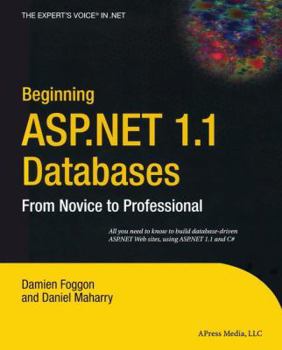Beginning ASP.Net 1.1 Databases: From Novice to Professional
This book picks up where Beginning ASP.NET: From Novice to Professional left off, focusing on database programming with ASP.NET. As an ASP.NET developer, you probably need to access your databases... This description may be from another edition of this product.
Format:Paperback
Language:English
ISBN:1590593693
ISBN13:9781590593691
Release Date:January 2004
Publisher:Apress
Length:600 Pages
Weight:2.19 lbs.
Dimensions:1.4" x 7.0" x 9.2"
Customer Reviews
3 ratings
Good introductory C# web book, bad title
Published by Thriftbooks.com User , 20 years ago
This is good book, but I don't think you will get what you want if you go from just the title alone. The is book is about database drive web applications using C#. There are two whole chapters on the front end ASP.NET layer using web controls and C#. Not that this is bad, mind you. The text is well written, the organization is fine, the graphics and illustrations are well done. The book starts with an analysis of the architecture of an ASP.NET data-driven web application. It then goes into hooking up your pages to a database server, running commands on the server, and getting data from the server onto pages and editing it. Stored procedures are also covered. Part three of the book was the best part for me. It starts with some practical advice about web application design that will save you a lot of time and frustration. It concludes with a case study that illustrates the real world use of what you have learned in all of the preceding chapters. This is an excellent walkthrough of the basics of ASP.NET. If you are looking for an introductory material then you should definitely consider this book.
Great DB help for beginners
Published by Thriftbooks.com User , 20 years ago
I have traditionally called myself a Web Designer, meaning that I developed websites in html and some occasional dhmtl. The sites were static in that the pages are not database driven. Except for size, the sites could forever remain in this fashion. They are mostly informational sites, where the basic information does not change, such as a church site or a religious ministry / teaching site. Size, of course, becomes a major factor. As minor changes or design changes are made, how does one integrate these changes across several hundred pages? This is not a unique issue, just an issue related to these type of sites. The answer, of course, is to move to a limited number of design pages while moving the content to the database. Most of those who view themselves as web developers (that is those with a programming background) would find this conclusion fairly obvious. In my situation, the matter was more complicated because one site would ultimately be a PHP / mySQL site while others would be ASP.NET / MS SQL powered. While some might argue for moving all of the sites to one or the other, I had no choice on the PHP site and my personal preference (at least on the front end) was to use ASP.NET. So, off I went in search of instructional materials. In the midst of this search, I was blessed by Beginning ASP.NET 1.1 Databases. I have found this book to be of major assistance and help because its sole focus in life is to teach the basics of the database side of the problem. While the work focuses on ASP.NET as the programming language, the focus is on the use of the databases. There is no sole focus on MS SQL, so the information becomes very portable to all programming languages. Most of the other works I encountered desire to teach the programming language first, then, or side-by-side, teach the database usage. In Beginning ASP.NET 1.1 Databases has the benefit of learning about database usage without attempting to focus on both programming and databases at the same time. The chapters are well organized and easy to read, while the examples are portable to other situations and make actual application easier to undertake. The real world case study (an HTML Reference system) is a pleasant change of pace from the other works, most of which want to delve into content management or yahoo portals. This is a well written, well thought out work that makes a great addition to one's reference and learning library, especially if one closer to the novice side of the scale.
A full solution
Published by Thriftbooks.com User , 20 years ago
The book is the functional equivalent of the many out there discussing using J2EE to build a dynamical website that is hooked to SQL databases. Foggon and Maharry show how if you are in the Microsoft .NET world, you can do likewise. They give a quick summary of earlier Microsoft efforts, like COM, Data Access Objects and Remote Data Objects. And how ADO 2.0 replaced the latter 2, and in turn is superceded by ADO.NET. The entire book is a not too subtle encouragement to migrate to ASP.NET and C#. There are solid technical explanations of why it is advantageous to do so. Like the relative ease of hooking to a back end SQL Server database, using high level classes like DataSet to pull stuff from the database, with a minimal knowledge of SQL needed. Then they show how the latest ASP can use this data to make dynamic HTML pages. Much like JSP and Java servlets. There is even a section on designing a database. Raising issues like normalisation and first and second normal forms. Though if this is new to you, then consider consulting a dedicated book on the subject.






